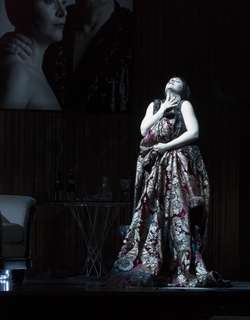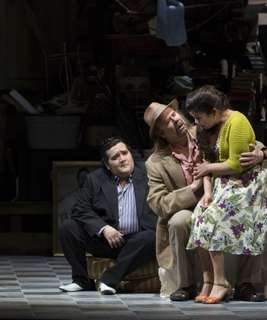|
Back
A winning pair Toronto
The Four Seasons Centre for the Performing Arts
04/26/2012 - and May 2, 5, 12, 15, 18, 20, 25, 2012
Alexander Zemlinsky: Eine florentinische Tragödie*
Giacomo Puccini: Gianni Schicchi
Alan Held (Simone*/Gianni Schicchi), Michael König (Guido Bardi*), Gun-Brit Barkmin (Bianca*/Nella), Simone Osborne (Lauretta), René Barbera (Rinuccio), Barbara Dever (Zita), Donato di Stefano (Simone), Peter McGillivray (Marco), Rihab Chaieb (La Ciesca), Adam Luther (Gherardo), Craig Irvin (Betto di Signa), Gabriel Gough (Gherardino), Doug McNaughton (Maestro Spinelloccio), Philippe Slye (Ser Amanto di Nicolao), Neil Craighead (Pinellino), Valerian Ruminski (Guccio)
The Canadian Opera Company Orchestra, Sir Andrew Davis (Conductor)
Catherine Malfitano (Director), Wilson Chin (Set Designer), Terese Wadden (Costume Designer), David Martin Jacques (Lighting Designer)

G.-B. Barkmin (© Chris Hutcheson)
The combination of Zemlinsky’s Eine florentinische Tragödie and Puccini’s Gianni Schicchi turns out to be a winner, at least in this new production directed by Catherine Malfitano with designs by Wilson Chin (sets) and Terese Wadden (costumes). And with baritone Alan Held in the two central roles it provides a great chance to appreciate a performer who rises to the occasion as well as he does.
This turns out to be the Canadian premiere of the Zemlinsky work. Gianni Schicchi was last performed by the COC in 1996 and staged then with I Pagliacci. This, by the way, is the only new production created by the company this season.
The two works were premiered less than two years apart and both are set in Florence during the Renaissance (or even pre-Renaissance in the case of the Puccini work). Here Both are set within the massive walls of a palazzo in which the decor has been updated. In the Zemlinsky work, the home of wealthy merchant Simone features hyper-glamorous moderne furnishings and his wife, Bianca, with her Louis Brooks hairstyle, is attired in equally sumptuous fashion. David Martin Jacques’s moody lighting helps create the very image of a film by the likes of Josef von Sternberg.
Somewhat lost in the shadows, both dramatically and vocally, is the wife’s lover, Prince Guido Bardi, (performed by Michael König). The action becomes less a love triangle than a cat-and-mouse game played by the husband (Alan Held, full of menace) and the wife, Gun-Brit Barkmin, who has made a role a specialty of late, and who capably performs the character-enhancing stylized movement that has been worked out for her. When she confides her love for Guido it seems that her feelings are really directed at her spouse. This diminishes the shock value of her exclamation after Simone has killed Guido: “Why have you never told me you are so strong?!”, but it helps draw out the idea of a subconscious urge in a work focused on sex and death.
The orchestral accompaniment is grand and rich (Straussian is the usual description) and, as it intertwines with the singers some vocalism gets covered. However Sir Andrew David (quite the local favourite after last season’s Ariadne auf Naxos and his long and ongoing connection with the Toronto Symphony Orchestra) brings forth the maximum colour and sensuousness from the augmented orchestra.

R. Barbera, A. Held, S. Osborne(© Chris Hutcheson)
For Gianni Schicchi the palazzo is further modernized and opened up to a picture postcard view of the city (we see this transformation during the interval). This work has had contemporary settings in many productions recently and in this case it works extremely well. If a prize mule seems incongruous as the most ardently desired item of Buoso’s estate one can only point out that it’s a goofy element in a historicist setting as well.
The grand room is dominated by the pile of possessions acquired by the hoarder Buoso Donati. The family has gathered to watch a football game on TV, and as they eat pizza and cheer their team, Buoso dies. This and other touches make for an amusing hour where Catherine Malfitano’s deft direction has resulted in a high degree of personal chemistry among the performers, especially the two young lovers, Rinuccio (René Barbera) and Lauretta (Simone Osborne). Malfitano’s experience as a stage performer (and a highly regarded one) no doubt informs her handling of the cast.
Ms Osborne scored a great success last fall as Gilda in Rigoletto. She is equally ideal for the role of Lauretta. “O mio babbino caro” gets the ovation we all want it to get - and a laugh when she signals a thumb-up to her boyfriend at the end. Mr Barbera has exactly the right youthful Italianate ping for this and so many similar roles.
The company’s recent happy trend toward strong casting is in evidence, as well as attention to detail. Barbara Dever is probably the standout among the venal relatives, although everyone performs a well-thought-out character to the hilt. Alan Held enthusiastically embraces the seedy rascality of his character.
As far as orchestration goes, Puccini comes out the winner vs Zemlinsky in that singers and orchestra are never in a combative relationship.
As far as I can tell, this is first time this pairing of these two works has been produced in North America. Given the high degree of collaboration between opera companies nowadays, we might expect to see this handsome production show up in other cities.
Michael Johnson
|